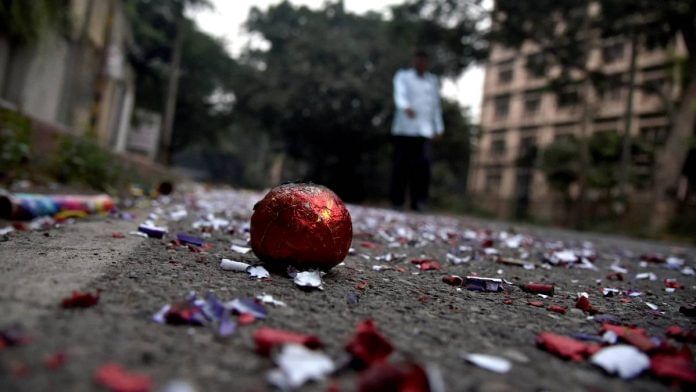It struck me on New Year — which, for us Gujaratis, comes right after Diwali — that when you live in Delhi, as I do, there’s a strange connection between Diwali and madness.
I felt it most strongly when I called people to wish them a happy New Year. Without exception, they all said the same things after greeting me back: “My eyes are burning,” or “My throat is really bad,” or “I am scared to go out because the air is so poisonous.”
People in Delhi will know what this is about. For the rest, here’s a quick explainer. Winter in Delhi, once the nicest time of year, has now become one of the worst seasons, because this is when the city turns into of the world’s most polluted cities.
As a consequence, firecrackers were banned in Delhi-NCR — but only on paper, not in practice. Inevitably, the ban sparked protests from Hindu groups, many of which, sadly, include people whose idea of a cogent argument goes something like this: ‘If Muslims can slaughter goats during Eid, why can’t Hindus burst crackers on Diwali?’
There’s a simple answer to that question: dead goats don’t poison the air or cause illness and suffering to lakhs of people. And yet, I can understand some of the grievance that thwarted Diwali revellers and fire-lovers feel when they are denied their bangs.
Also read: Bursting firecrackers on Diwali isn’t the problem. Making it a national and moral issue is
Laying the groundwork for pollution
The problem starts when grievance is weaponised for political reasons. When it was in opposition, the Bharatiya Janata Party (BJP) turned the fireworks ban into a major issue, using it to paint the ruling Aam Aadmi Party (AAP) as “anti Hindu”. But now that it is in power, the BJP has had no choice but to push for a return to full-blown fireworks celebrations.
Unfortunately, Diwali coincided with a massive jump in pollution levels in Delhi. So, on the one hand, the government announced restrictions on construction, vehicles, and the like. On the other, it facilitated the return of a huge mass pollutant by pushing for fireworks.
The Supreme Court played it safe. It was fine to set off fireworks, it said, but only if they were “green fireworks”.
Green fireworks?
No, me neither. Nobody in Delhi had any clue what these “green bangers” were, so shopkeepers just slapped green tags on regular fireworks, knowing there would be no enforcement of the ‘use-only-green’ rule.
You can guess how this went. On Diwali night, there were so many fireworks that pollution reached staggering levels. Many of the centres that monitor air quality stopped functioning, either because the BJP didn’t want a record of the poison in the air (the conspiracy theorists’ version) or because the levels were so far off the charts that the machines simply couldn’t measure them (also entirely possible).
Also read: A to Z of AQI—Why Delhi can’t breathe easy
Madness cycle runs like clockwork
You may ask what all this has to do with madness. Well, let’s start with surrealism. In which sane world would a government that imposes countless restrictions in the name of controlling pollution also advocate the spread of mass pollutants, so that the air in the capital becomes worse than poison?
There’s a definition of madness that seems well suited to today’s Delhi: doing the same thing again and again and expecting a different result. And that sums up the attitude of every government — whether AAP or BJP — to Delhi’s pollution problem.
Nobody agrees on what creates the problem. Is it construction? Is it the number of cars on the road? Is it stubble burning by farmers in Punjab and Haryana?
Maybe it’s all of the above. We can’t be sure. But what we do know is that every autumn and winter, the government blames one of these factors and announces new restrictions and anti-pollution measures. None of them really work. And when the weather changes after a few months and pollution levels drop, the entire issue is quietly forgotten.
Then, as the next autumn arrives, along with the smog, the government announces exactly the same measures that failed the previous year. And the cycle begins again.
Mad? You bet.
Well, that’s what life in Delhi is like these days. And so, after three decades in the city, what can I say?
Not much, except this: with a catch in my throat and tears in my eyes (courtesy of toxic air) — Happy New Year!
Vir Sanghvi is a print and television journalist and talk show host. He tweets @virsanghvi. Views are personal.
(Edited by Prashant)







While you call this a madness, there are other things you need to work upon and highlight.
YOU really called one day of burning crackers a madness. You need to some physico consultation.